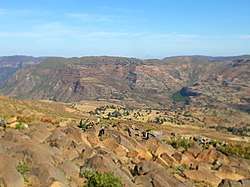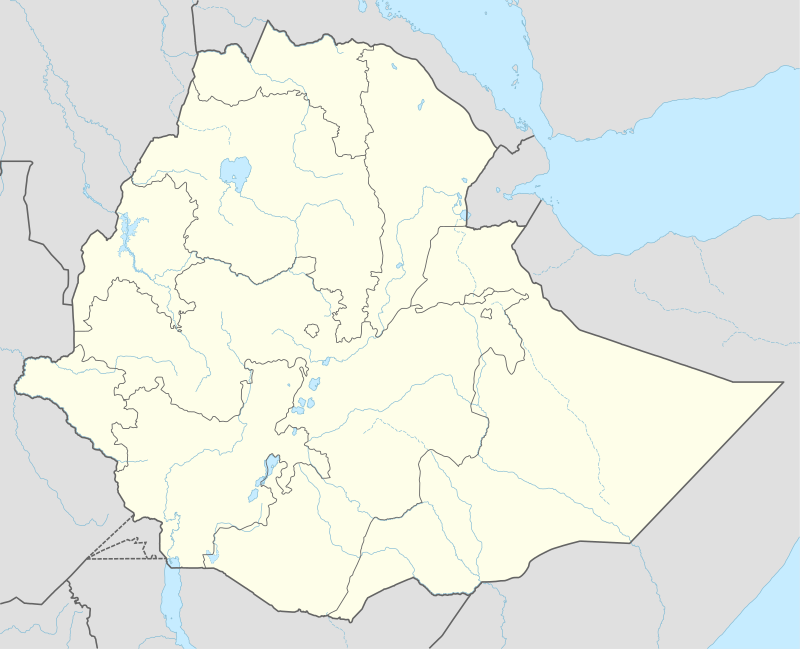Menachek
Menachek is a tabia or municipality in the Dogu'a Tembien district of the Tigray Region of Ethiopia. The tabia centre is in Addi Bayro village (also called "Debre Birhan"), located approximately 12 km to the southwest of the woreda town Hagere Selam.
Menachek | |
|---|---|
 | |
 Menachek Location within Ethiopia | |
| Coordinates: 13°35′N 39°5′E | |
| Country | Ethiopia |
| Region | Tigray |
| Zone | Debub Misraqawi (Southeastern) |
| Woreda | Dogu'a Tembien |
| Area | |
| • Total | 16.32 km2 (6.30 sq mi) |
| Elevation | 2,580 m (8,460 ft) |
| Time zone | UTC+3 (EAT) |
Geography
The tabia occupies the flanks of the valley of the Tsech'i River that drains Dogu'a Tembien to the west. The highest peak is near Welekhlekha (almost 2700 m a.s.l.) and the lowest place in the lower Tsech'i gorge (1920 m a.s.l.).
Geology
From the higher to the lower locations, the following geological formations are present:[1]
Geomorphology and soils
The main geomorphic units, with corresponding soil types are:[2]
- Hagere Selam Highlands, along the central basalt and sandstone ridge
- Associated soil types
- Inclusions
- Rock outcrops and very shallow soils (Lithic Leptosol)
- Rock outcrops and very shallow soils on limestone (Calcaric Leptosol)
- Deep dark cracking clays with very good natural fertility, waterlogged during the wet season (Chromic Vertisol, Pellic Vertisol)
- Shallow stony dark loams on calcaric material (Calcaric Regosol, Calcaric Cambisol)
- Brown loamy soils on basalt with good natural fertility (Luvisol)
- Adigrat Sandstone cliff and footslope
- Associated soil types
- Inclusions
- shallow, dry soils with very high amounts of stones (Leptic and Skeletic Cambisol and Regosol)
- deep, dark cracking clays with good fertility, but problems of waterlogging (Chromic and Pellic Vertisol)
- soils with stagnating water due to an abrupt textural change such as sand over clay (Haplic Planosol]])
Climate
The rainfall pattern shows a very high seasonality with 70 to 80% of the annual rain falling in July and August. Mean temperature in xxx is 17.4 °C, oscillating between average daily minimum of 9.6 °C and maximum of 24.8 °C. The contrasts between day and night air temperatures are much larger than seasonal contrasts.[3]
Springs
As there are no permanent rivers, the presence of springs is of utmost importance for the local people. The main springs in the tabia are:[4]
- May Gfay
- May Tsechi
- Gigbana
Reservoirs
In this area with rains that last only for a couple of months per year, reservoirs of different sizes allow harvesting runoff from the rainy season for further use in the dry season.
- Traditional surface water harvesting ponds, particularly in places without permanent springs, called rahaya
- Horoyo, household ponds, recently constructed through campaigns[5]
Agriculture and livelihood
The population lives essentially from crop farming, supplemented with off-season work in nearby towns. The land is dominated by farmlands which are clearly demarcated and are cropped every year. Hence the agricultural system is a permanent upland farming system.[7] The farmers have adapted their cropping systems to the spatio-temporal variability in rainfall.[8] An elongated rugged landscape extends to the west of the tabia, which is used for transhumance.
History and culture
Caves and archaeological sites
The Danei Kawlos cave in the Tsech'i gorge at the west of Menachek at an elevation of about 2020 metres, is some 13.5 metres long (13.621862°N 39.033077°E). It contains lithic tools, potsherds, and faunal remains of Pastoral Neolithic age.[9] Further down, the May Ila open-air site in the Tsech'i gorge at the extreme west of Menachek at a height of about 1990 metres (13.609826°N 39.028260°E) contains blades, blade cores, and a few potsherds of Pastoral Neolithic age.[9]
History
The history of the tabia is strongly confounded with the history of Tembien.
Religion and churches
Most inhabitants are Orthodox Christians. The Gulha Maryam church with its large forest is located in the tabia.
Inda Siwa, the local beer houses
In the main villages, there are traditional beer houses (Inda Siwa).
Roads and communication
The main road Mekelle – Hagere Selam – Abiy Addi runs 2 to 5 km south and east of the tabia. There are regular bus services to these towns. Further, a rural access road links Addi Bayro and Welekhlekha to the main asphalt road.
Tourism
Its mountainous nature and proximity to Mekelle makes the tabia fit for tourism.[10] The high variability of geological formations and the rugged topography invites for geological and geographic tourism or "geotourism".[11] Trekking routes 7 and 19 pass along the southern ridge in this tabia.[12] The tracks are not marked on the ground but can be followed using downloaded .GPX files.[13] They link Inda Maryam Qorar to Debre Sema'it rock church. Facilities in Menachek are very basic.[14]
See also
- Dogu'a Tembien district.
References
- Sembroni, A.; Molin, P.; Dramis, F. (2019). Regional geology of the Dogu'a Tembien massif. In: Geo-trekking in Ethiopia's Tropical Mountains - The Dogu'a Tembien District. SpringerNature. ISBN 978-3-030-04954-6.
- Nyssen, Jan; Tielens, Sander; Gebreyohannes, Tesfamichael; Araya, Tigist; Teka, Kassa; Van De Wauw, Johan; Degeyndt, Karen; Descheemaeker, Katrien; Amare, Kassa; Haile, Mitiku; Zenebe, Amanuel; Munro, Neil; Walraevens, Kristine; Gebrehiwot, Kindeya; Poesen, Jean; Frankl, Amaury; Tsegay, Alemtsehay; Deckers, Jozef (2019). "Understanding spatial patterns of soils for sustainable agriculture in northern Ethiopia's tropical mountains". PLOS ONE. 14 (10): e0224041. doi:10.1371/journal.pone.0224041. PMC 6804989. PMID 31639144.
- Jacob, M. and colleagues (2019). Dogu'a Tembien's Tropical Mountain Climate. In: Geo-trekking in Ethiopia's Tropical Mountains - The Dogu'a Tembien District. SpringerNature. doi:10.1007/978-3-030-04955-3_3. ISBN 978-3-030-04954-6.
- What do we hear from the farmers in Dogu'a Tembien? [in Tigrinya]. Hagere Selam, Ethiopia. 2016. p. 100.
- Developers and farmers intertwining interventions: the case of rainwater harvesting and food-for-work in Degua Temben, Tigray, Ethiopia
- Jacob, M. and colleagues (2019). Geo-trekking map of Dogu'a Tembien (1:50,000). In: Geo-trekking in Ethiopia's Tropical Mountains - The Dogu'a Tembien District. SpringerNature. ISBN 978-3-030-04954-6.
- Nyssen, J.; Naudts, J.; De Geyndt, K.; Haile, Mitiku; Poesen, J.; Moeyersons, J.; Deckers, J. (2008). "Soils and land use in the Tigray highlands (Northern Ethiopia)". Land Degradation and Development. 19 (3): 257–274. doi:10.1002/ldr.840.
- Frankl, A. and colleagues (2013). "The effect of rainfall on spatio‐temporal variability in cropping systems and duration of crop cover in the Northern Ethiopian Highlands". Soil Use and Management. 29 (3): 374–383. doi:10.1111/sum.12041.
- Agazi Negash. (2001). The Holocene Pre-Historic Archaeology of the Temben Region of Northern Ethiopia (PhD dissertation). University of Florida.
- Geo-trekking in Ethiopia's Tropical Mountains - The Dogu'a Tembien District. SpringerNature. 2019. ISBN 978-3-030-04954-6.
- Miruts Hagos and colleagues (2019). Geosites, Geoheritage, Human-Environment Interactions, and Sustainable Geotourism in Dogu'a Tembien. In: Geo-Trekking in Ethiopia's Tropical Mountains, the Dogu'a Tembien District. SpringerNature. doi:10.1007/978-3-030-04955-3_1. ISBN 978-3-030-04954-6.
- Nyssen, Jan (2019). Description of Trekking Routes in Dogu'a Tembien. GeoGuide. Springer-Nature. pp. 557–675. doi:10.1007/978-3-030-04955-3_38. ISBN 978-3-030-04954-6.
- https://www.openstreetmap.org/traces/tag/nyssen-jacob-frankl
- Nyssen, Jan (2019). "Logistics for the Trekker in a Rural Mountain District of Northern Ethiopia". Geo-trekking in Ethiopia's Tropical Mountains. GeoGuide. Springer-Nature. pp. 537–556. doi:10.1007/978-3-030-04955-3_37. ISBN 978-3-030-04954-6.